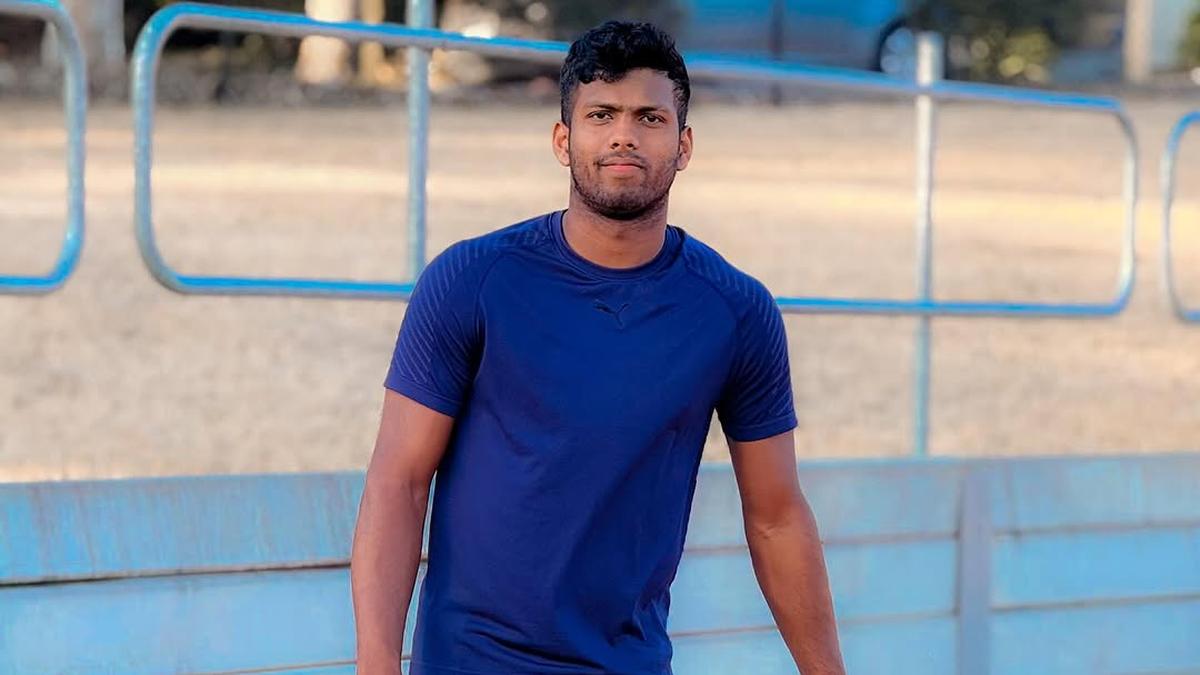Sri Lankan javelin thrower Rumesh Tharanga ditches cricket’s fast lane to soar into the skies, targets Olympic gold in 2036
Once amongst Sri Lanka’s quickest pace bowlers as a 16-year-old, Rumesh Tharanga is currently the world leader in the javelin throw. The 21-year-old is the latest elite athlete in the event from the subcontinent.
They might have felt confident when they saw him begin his short 12-step run-up, but batters in a recent club game in Brisbane were in for a rude awakening once Rumesh released the cricket ball from his hand. Rumesh was deceptively fast, having the players duck and sending the stumps flying.
More than a few would have wondered if the 21-year-old – who had been brought along by a friend – had any cricketing pedigree. A few might have even wondered just how quick he would be if he sprinted in from a genuine fast bowler’s run-up. Cricket, though, is just for fun, according to Rumesh. He’s saving his full length 18-stride run up for the athletics track.
Five years ago, as a young sportsperson in Sri Lanka, Rumesh indeed had a choice to make – cricket or track and field. The choice was hard. The then 16-year-old was legitimately one of Sri Lanka’s fastest bowling juniors – one of his deliveries clocked 134kmph on the speed gun and won him second place in the U-18 category at the 2019 Airtel Fastest – a nationwide pace talent search won by recent Sunrises Hyderabad pick Eshan Malinga. But while a career in cricket beckoned, Rumesh ended up choosing the less glamorous option of track and field.
It is a decision that has worked out well. Last Sunday, competing at the Perth Track Classic in Perth, Australia, Rumesh flung his javelin 85.41m. It’s still early days in the 2025 athletics season but for now, the Sri Lankan has found his way rather unexpectedly onto the top of the world list this year.
“I’m happy to be in this place, but realistically, it’s still very early in the season. Many throwers have not started yet. I’d like to be in the same position in July or August this year. For the moment this feels good,” Rumesh tells Sportstar from his base in Brisbane where he currently trains along with two-time world champion and Olympic bronze medallist Kelcey Barber and her coach Mike Barber.
Should he continue to stay at the top of the charts, Rumesh would be the latest data point on a steadily strengthening trend in track and field. The javelin throw event might have been dominated by European athletes at one point in time, but in recent years, the subcontinent is where some of the best throwers – the reigning world champion (Neeraj Chopra) and Olympic champion (Arshad Nadeem of Pakistan) – have come from.
“It’s good to have these countries having good javelin throwers. If you can win a medal at the Asian or even at the South Asian level, you have to be world-class. If you win a medal here, chances are high that you can medal at the Olympics and World Championships,” he says.
‘Want to be like Neeraj’
Of the two big talents in the subcontinent, it is Neeraj whom Rumesh admires more. “I’m inspired by both Arshad and Neeraj. I like the consistency of Neeraj over the last 4-5 years. He hits big throws repeatedly. If he does six throws, all of them will be over 86 metres. Arshad is a powerful thrower. He will cross 90-91 metres but he will get that maybe once in a competition. I like Neeraj’s consistency more. He’s someone I’d want to be like,” he says.
Neeraj wasn’t always Rumesh’s role model.
The son of a policeman in the village of Horana, some 50 kilometres away from Sri Lanka’s capital city of Colombo, Rumesh played both cricket as well as track and field. “The first sportsperson I admired was Mitchell Starc. I also wanted to be a fast bowler,” he says.
He was talented at both, playing for his province at the age-group level but also being good enough to earn a track scholarship with St. Peters College in Colombo – a school renowned for its athletics program. While he tried to pursue both sports, eventually he decided to focus on throwing. “Both the javelin throw and fast bowling are high-stress activities and I would probably have got injured if I tried to do both,” he says.
His coach Tony Prasanna also convinced him to switch to the javelin throw full time. “There are many factors to be successful in cricket. Apart from talent, a lot depends on the kind of support system you get, the kind of club you play for or whether you are spotted by someone who is influential. I’ve seen so many talents not going the distance in cricket. In an individual event like track and field, no one can stop you. If you throw 85 metres, everyone can see it. You can’t have favourites here. I told Rumesh track and field was where his true potential could be seen,” he says.
READ: Indoor 4x400m mixed relay announced as official discipline by World Athletics
Sri Lanka has had it’s share of success in track and field – Susanthika Jayasinghe was the first Asian woman to win an Olympic medal in the sprint event when she won silver in the 200m at the Athens Games, while Yupun Abeykoon is the only athlete from South East Asia to break the 10-second barrier in the men’s 100m. The island nation has even produced talent in the javelin throw. Back in 2016 veteran thrower R. M. Sumedha Ranasinghe’s personal best (83.04m) was the South Asian record before the rise of Neeraj. However it was the latter’s success that really encouraged Rumesh’s coach to encourage him to focus on the javelin.
“When Neeraj started, there was a Sri Lankan thrower who was better than him. But he couldn’t progress to the same level as Neeraj did. It’s because of Neeraj that there’s a certain aura about the javelin throw,” he says.
Lucky break
Rumesh threw both the discus and javelin before eventually settling on the latter. He competed at the 2022 Junior World Championships where he finished seventh, before moving to the seniors.
While Rumesh’s decision to switch to the javelin has worked well for him, it hasn’t always been easy. While politics and luck might have been a factor in cricket, the fact remains that that sport is far better funded than track and field, particularly the javelin. Sri Lanka, Rumesh’s coach points out, has only one synthetic track on which he can practise. For funds, he largely depends on his income as a member of the Sri Lankan Air Force. In fact, the lack of adequate support could be why it’s only in 2025 that Rumesh has gone to the top of the world list.
He made heads turn on May 15 last year when he won gold at the Asian Throwing Championships in Korea with a throw of 85.45m. That throw marked a huge improvement on his previous best mark of 76.45m set in 2023. It’s possible that Rumesh could have thrown further sooner but the Asian Throwing Championships were the first time the Sri Lankan athlete ever used a javelin capable of being thrown that far. “The Asian Championships were my first senior international competition. Before that, I had been using a Nemeth javelin rated at 70m. I had wanted to use a stiffer javelin and I had also tried to raise money to buy one but I was not successful,” he says.
All javelins flex when thrown – the amount they bend when force is applied. The more rigid ones travel further but are less tolerant of bad technique while the more flexible ones put less stress on the elbow but also fly less far. The javelin distance rating is the prediction of what distance a thrower is likely to achieve from that javelin. Javelins that are more flexible are much cheaper than the more rigid ones – which can retail for close to a thousand dollars each.
“When I went to the competition, the organisers didn’t allow me to use my own javelin so I ended up borrowing a javelin rated at 90 metres from a Kuwait thrower. In my fourth throw with it, I crossed 85 metres. To tell you the truth, I wasn’t expecting to throw that much. Even the Kuwaiti athlete who lent me his javelin was surprised. He told me that was the first time his javelin had crossed 75m,” Rumesh says.
ALSO READ: World Athletics road running champs 2025 to be moved from San Diego
Although he won gold at the Asian Throwing Championships, Rumesh says the moment was bittersweet. “I was a little disappointed because I’d just missed out on qualifying for the Olympics by just five centimetres (the Olympic qualification standard was 85.50m). But at the same time, that competition gave me a lot of confidence because I had crossed 85m when I was just 20 years old. I was thinking I’d only throw 85 metres only around 2026. Next time, I won’t just be thinking about qualification, I’ll be thinking about winning a medal,” he says.
A few months later, Rumesh was finally provided the kind of javelin that had won him the gold at the Asian Championships. That javelin was a Nordic Valhalla – the same model that India’s Neeraj used to win both his Olympic medals and World Championship gold.
Big targets
This year, Rumesh has also been able to train overseas – at the Queensland Institute of Sport alongside Mike and Kelcey who have waived their usual coaching fee. “It’s a great advantage to be able to train in Australia. In Australia, everything – the facilities, environment and ecosystem – helps me,” he says.
Rumesh isn’t planning on staying satisfied with his current season’s best. “In my last competition, I had five out of my six attempts go over 80m. I was averaging around 82m with each throw. I’ve already done 85m in competition both this year and last year. So, I think I can do more,” he says.
While his improvement has been prodigious, Rumesh says he isn’t trying to push too fast too soon. “I haven’t pushed myself completely. I think I will try to improve my personal best in a month or so. I want to preserve myself for the end of the season,” he says.
His coach agrees with this. Standing at 6 feet and 2 inches and weighing 86kg, one would suppose Rumesh is a powerfully-built athlete. But coach Tony says he’s still got some way to develop physically. “He’s still very young. He will get stronger. Our first key target is the 2028 Olympics and we know we have some time for that,” he says.
However, the plan isn’t to get Rumesh too bulky. “He’s improved by about six metres from his personal best every other year. Even this year, if you count his training throws, Rumesh has thrown over 85 metres about 12 times. His best qualities are his speed on the runway and rhythm, so we aren’t trying to add too much muscle on him too quickly. ‘Speed and rhythm’ is the model we trust and I’m confident that is the same model that will give us our next 5-metre improvement. And you know what that magic number (90 metres) will be,” he says.
While that might be a major milestone, Rumesh doesn’t want it to be the only one. “I want to throw far but I want to compete for a long time as well. I’ve heard that India is bidding for the 2036 Olympics and I would really like it if I could retire after winning the Olympic gold in India,” he says.


